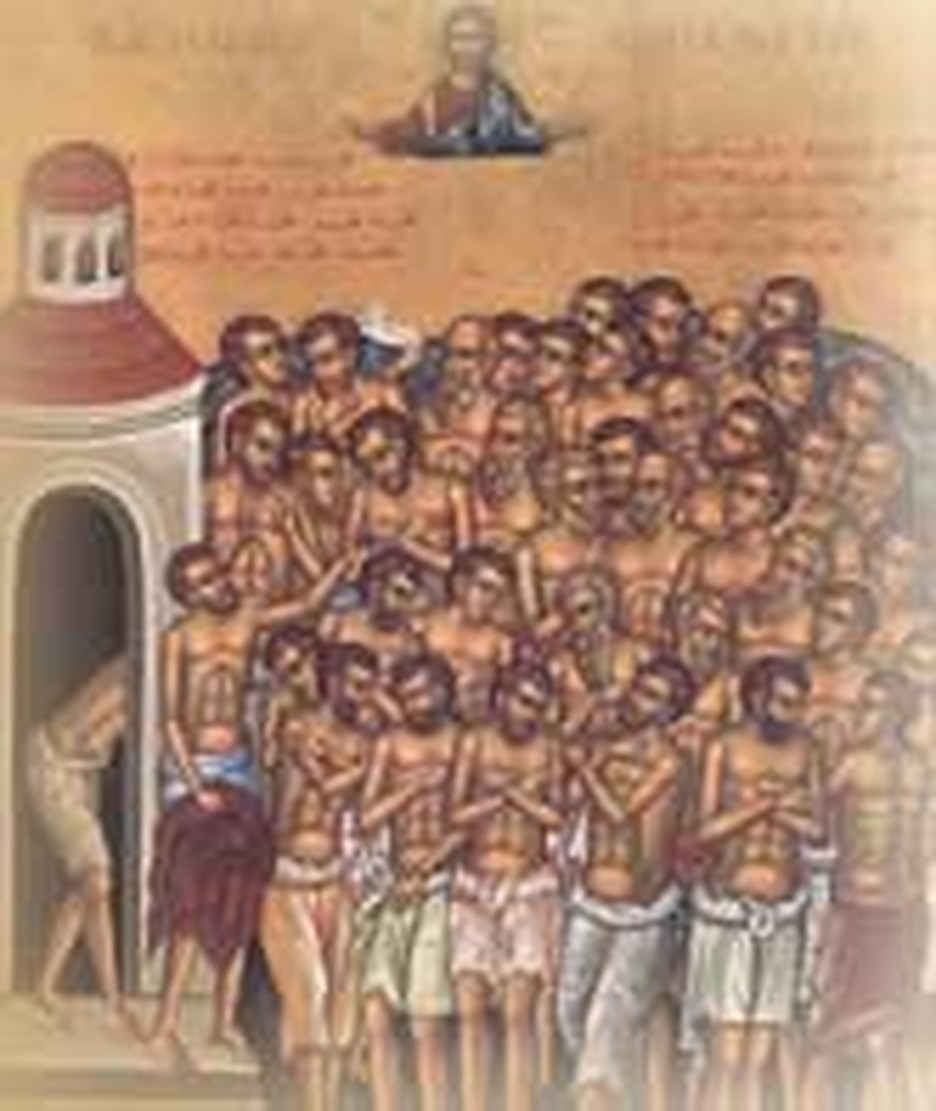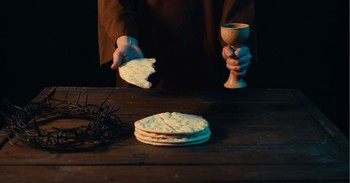
It was one of the strangest episodes in all of military and Christian history--an army killing its own best soldiers. The time: A.D. 320. The place: Sevaste, in present-day Turkey. The issue: Would Christian soldiers obey and bow to pagan gods?
Governor Agricola spoke mildly but firmly. He had good and strong warriors before him. He needed them. They must be brought into line. "I am told you refuse to offer the sacrifice ordered by Emperor Licinius."

One of the soldiers answered on behalf of the rest. "We will not sacrifice. To do so is to betray our holy faith."
"But what about your comrades? Consider--you alone of Caesar's troops defy him! Think of the disgrace you bring upon your legion. How can you do it?"
"To disgrace the name of our Lord Jesus Christ is more terrible still."
A note of exasperation crept into the governor's voice. "Give up this stubborn folly. You have no lord but Caesar! In his name, I promise promotion to the first of you who steps forward and does his duty." He paused a moment, expecting his lure would break their ranks. None of them moved. He switched tactics. "You persist in your rebellion? Then prepare for torture, prison, death! This is your last chance. Will you obey your emperor?"
The soldiers stood firm, although they well knew the governor would carry out his threat. They spoke: "Nothing you can offer us would replace what we would lose in the next world. As for your threats--we've learned to deny our bodies where the welfare of our souls is at stake."
Agricola ordered, "Flog them." Pairs of guards seized each man and dragged them out into the cold where they were stripped and tied to posts. Soon the swish of whips and the thud of blows filled the air with groans. Hooks of iron tore the men's sides. Unbelievably, although their flesh was bruised, their skins were tattered and their blood flowed, not one of the forty surrendered.
"Chain them in my dungeons!" roared Agricola. "We'll see what Lysias has to say about this."
Lysias, commander of the 12th Legion, was in no gentle mood when the forty Christian soldiers were hauled before him a few days later. His ride from Antioch to Sevaste had been tedious and cold. "You will obey me," he said sternly, "or pay a sharp penalty."
The men answered him with respectful defiance, just as they had Agricola. Lysias had not become a commander by coddling traitors, and he did not intend to begin now. He motioned to Agricola.
Agricola came beside Lysias. As judge, he must make these unbending men conform. But how? Just then, a frigid gale blew across the frozen pond below and stabbed into his cheeks. It gave him an idea. "Take them down to the pond," he ordered. Turning to the soldiers he added, "You will stand naked on the ice until you agree to sacrifice to the gods."
Agricola could hardly believe what his eyes saw next. The rebels began stripping off their own clothes and running toward the pond in the freezing March air. "We are soldiers of the Lord and fear no hardship," shouted one. "What is our death but entrance into eternal life?"
Sing It, Brothers!
Striking up a song, the men marched onto the frozen pond. Baffled, Agricola posted guards around them. He squinted into the falling sun. Surely the bitter cold of evening would change their minds....
Wait! There was something else he could do. "Heat baths of warm water," he ordered the guards. "Place them around the pond. That ought to lure them out pretty quickly," he smirked.
The sun sank behind the hills. Then upon the night air could be heard a prayer: "Lord, there are forty of us engaged in this battle; grant that forty may be crowned and not one be missing from this sacred number."
Standing on the shore, the shivering guards shouted into the night. "Don't be idiots. What's the point? Come on out. Warm yourselves!"
"Look," one of the guards suddenly exclaimed, pointing toward the sky.
"What?" said his fellow guard, eyes probing the darkness. "Its too dark to see anything. By Jove, I wish this was over. I'm freezing out here."
"Don't you see them? Spirits...hovering with golden crowns over those fellows heads, holding out rich robes for them!"
"Are you out of your mind? It's pitch black. Hey! There's someone coming! It's one of them."
Babbling, one of the forty crawled toward them from the ice. The two ran forward, grasped his shuddering arms and helped him into a bath. But the heat was too much of a shock to his frozen system. He went into convulsions and died.
The guard who had seen the vision of crowns, without delay, shucked off his clothes and ran onto the ice. The martyrs would be forty again!
When the sun rose, Agricola was told that the forty were dead. "Well, get the bodies off the ice," he commanded. "Burn them. And dump the ashes in the river."
The Youngest Was Still Alive
The guards backed a wagon as near the pond as they could and began stacking the stiff corpses onto it. Then a bizarre twist occurred.
"Hey, we've got a live one here," a guard shouted. "It's Melito. Poor fellow. He's just a kid."
"A local boy, too. That's his mom up there." The soldier beckoned to the woman and she came near. "Listen, Mother, take your boy home, save his life if you can. We'll look the other way."
"What kind of talk is that?" scolded the woman. She seemed genuinely upset! The guards looked at each other in astonishment. "Would you cheat him of his crown? I'll never let that happen!" As the wagon began to roll away, she lifted her son with her peasant's strength, hoisting him in with the others.
"Go, Son," she cried. "Go to the end of this happy journey with your comrades so that you won't be the last to present yourself before God."
One of the guards tapped the side of his head and rolled his eyes upward. "Christians!" he muttered. "I just don't understand them."
Fascinating Facts Behind the Forty Martyrs of Sevaste
How many agreed to sacrifice? A legion consisted of from 3,000 to 6,000 infantry plus cavalry. Apparently at least 2,960 men from the Sevaste legion sacrificed at Licinius's order. Barely 1% bucked his demand!
The famous Thundering Legion. The legion stationed at Sevaste may have been the famed Thundering Legion. Dating back to Caesar Augustus, it took its name from a lightening emblem on its shields. The Thundering Legion is connected with another unusual historical event. During the reign of Marcus Aurelius, it was trapped in a dry valley and only saved from dying of thirst by a furious thunderstorm which provided drinking water and threw enemy soldiers into panic. Christian writers spoke of the thunderstorm as a miracle in answer to the petitions of a group of praying Christian soldiers. Pagan authors attributed it to sorcery or to the prayers of Marcus Aurelius.
Why a legion of troops in Sevaste? Licinius had to defend against Barbarians and Persians. Sevaste (now Sivas, Turkey) was a logical place to station a sizable force to meet challenges from North and East.
Save the remains. The bodies of the Forty were burned and their ashes cast into a river. The current deposited fragments of bone at a bend in the stream. Christians collected and preserved them as honored remains to be kept among local churches.
Sevaste (now Sivas, Turkey) was in Armenia. It was a strategic location to station troops to meet threats from North and East.


Too Incredible to Be True?
Are we really supposed to believe that forty men in the prime of life voluntarily undressed to die by freezing? Is this just a legend?
Actually, the story is as solid as ancient history gets. There are at least three sources for it. The men were martyred in 320. Gregory of Nyssa (c.335-396) tells that he was still a boy when a feast was established in their memory and churches dedicated to them. He wrote two sermons on them and declared his intention to bury his parents beside the remains of some of the brave soldiers.
When Gregory's brother, Basil the Great, Bishop of Caesarea (c.330-379), preached a sermon on the feast day of the Forty Martyrs, there were still men and women alive who remembered the brave fellows. Basil's sermon, by the way, is the oldest written record we have of their icy death, and was preached in a church named for the Forty Martyrs.
Another person who later wrote about the martyrs was actually alive as a fourteen year old boy when they spent their night on the ice. Ephrem the Syrian (c.306-373) became a leading Christian scholar and hymn writer. He spent much of his life in Edessa, about two hundred miles south of Sevaste. Among his many poems was a eulogy on The Forty.
That Day the North Wind Did Blow
The day was very cold. Surely I do not have to inform you about the cold since today's weather gives you a clear idea about it. The chill even penetrates the walls....such was the season of the contest and the time of their miracles when the north wind blew so vehemently.--Gregory of Nyssa's 1st Sermon on the Forty Martyrs
Did Licinius Kill for Spite?
It is commonly and inaccurately stated that Constantine made Christianity the official religion of the Roman Empire when he became emperor. Not so. It was Theodosios I over a half-century later with his edict of 380. Constantine actually came to power with a co-emperor Licinius.
In 313, Licinius needed Constantine's help and struck a deal with him. To seal the bargain, Constantine married his sister to Licinius. The two generals issued the edict of Milan, granting religious toleration to the empire. Licinius even fought under a Christian banner.
So what changed? Why did Licinius turn on the Christians in 320? Both wanted the same thing --single control over the empire. Persecuting Christians was one way for Licinius to show how much he hated Constantine, whose favor for the Christian faith was well known.
Out of Place Christians?
What were Christians doing in the army? Early Christian writers tell us that Christians believed it was wrong to fight and kill. Could it be that The Forty were draftees? Or had Christians decided it was okay to fight as long as they did so under a Christian banner? Perhaps the men converted to Christ after enrolling in the armed forces.


